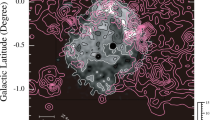Abstract
In an analysis of NO−3 in an Antarctic ice core we have found four spikes of high concentration, three of which occur at depths which correspond roughly to the dates of known galactic supernovae (SN). The production of the observed NO−3 peaks by the hard X rays generated by a SN outburst (particularly Type I) does not seem inconceivable at least from the point of view of energy requirements and current SN models. We predict that the bright SN of 1006 will be ‘Observed’ about 15 m beyond the end of the current core. If this is true, our identification of these spikes with SN will have important consequences for the theory of SN, atmospheric chemistry and transport, and even the dating of ice cores.
Similar content being viewed by others
References
Parker, B. C., Heiskell, L. E., Thompson, W. J. & Zeller, E. J. Nature 271, 651–652 (1978).
Zeller, E. J. & Parker, B. C. in Informal Colloquium on Solar Variability (ed. Eddy, J.) (University of Colorado, Boulder, 1978).
Zeller, E. J. & Parker, B. C. in Planetary Water and Polar Processes (ed. Murphy, D.) 186–192 (Hanover, New Haven, 1978).
Eddy, J. A. Science 192, 1189–1202 (1976).
Clark, D. H. & Stephenson, F. R. The Historical Supernovae (Pergamon, Oxford, 1979).
Becker, R. H. et al. Astrophys. J. Lett. 209, L65–L68 (1976).
Mills, B. Y., Slec, O. B. & Hill, E. R. Aust. J. Phys. 14, 497–507 (1961).
Chevalier, R. A. & Kirshner, R. P. Astrophys. J. 219, 931–941 (1978).
van den bergh, S. Astrophys. J. 165, 457–469 (1971).
Ruderman, M. A. Science 184, 1079–1081 (1974).
White, O. R. in Solar Output and its Variation (ed. White, O. R.) 26 (University of Colorado, Boulder, 1977).
Gursky, H. & Schwarz, D. in X-Ray Astronomy (eds Giacconi, R. & Gursky, H.) 26 (Reidel, Dordrecht, 1974).
Klein, R. I. & Chevalier, R. A. Astrophys. J. 223, L109–L112 (1978).
Arnett, W. D. Astrophys. J. Lett. 230, L37–L40 (1979).
Bauer, E. Nature 276, 96 (1978).
Parker, B. L., Heiskill, L. E., Thompson, W. J. & Zeller, E. J. Nature 276, 97 (1978).
Chevalier, R. A. in Supernovae, (ed. Schramm, D. N.) 53–61 (Reidel, Dordrecht, 1977).
Weiler, K. W. & Panagia, N. Astr. Astrophys. 70, 419–422 (1978).
Stephenson, F. R., Clark, D. N. & Crawford, D. F. Mon. Not. R. astr. Soc. 180, 567–584 (1977).
Author information
Authors and Affiliations
Rights and permissions
About this article
Cite this article
Rood, R., Sarazin, C., Zeller, E. et al. X- or γ rays from Supernovae in glacial ice. Nature 282, 701–703 (1979). https://doi.org/10.1038/282701a0
Received:
Accepted:
Issue Date:
DOI: https://doi.org/10.1038/282701a0
- Springer Nature Limited
This article is cited by
-
250 years of accumulation, oxygen isotope and chemical records in a firn core from Princess Elizabeth Land, East Antarctica
Journal of Geographical Sciences (2006)
-
The record of global pollution in polar snow and ice
Nature (1985)
-
Thermoluminescence in sediments and historical supernovae explosions
Il Nuovo Cimento C (1982)
-
Supernovae and nitrate in the Greenland Ice Sheet
Nature (1981)
-
Giant solar flares in Antarctic ice
Nature (1980)





